 |
Revista
EIDENAR: Ejemplar 7 / Enero - Diciembre 2008 |
 |
Germination of
grass seeds subjected to stationary magnetic field
|
|
|
|
*Recibido
:
Septiembre 10 2007
|
*Aceptado:
Julio 16 2008 |
|
|
Mercedes
Flórez García,
Ph.D.
Ingeniero Agrónomo. Profesor
Departamento Física y Mecánica,
Universidad Politécnica de Madrid-España.
Elvira
Martínez Ramírez, Ph.D.
Ciencias Químicas. Profesor Titular
Departamento Física y Mecánica,
Universidad Politécnica de Madrid-España. |
María Victoria
Carbonell Padrino,
Ph.D.
Ingeniero Agrónomo. Profesor Titular
Departamento Física y Mecánica,
Universidad Politécnica de Madrid-España.
victoria.carbonell@upm.es |
| |
|
|
| |
RESUMEN
El
objetivo
de este estudio es determinar y cuantificar el efecto de un campo
magnético estacionario en la germinación de semillas
patrenses (Festuca arundinacea and Medicago sativa, L.). Las semillas
fueron expuestas a 250 mT durante distintos periodos de tiempo: 10
minutos, 20 minutos, 1 hora, 24 horas ó de forma crónica,
dosis (B1-B5). Los parámetros utilizados fueron: tiempo medio de
germinación (TMG) y el tiempo necesario para que germine el 1,
10, 25, 50 y 75% de semillas (T1-T75) proporcionados Seedcalculator
software.
De los resultados obtenidos con semillas de alfalfa se desprende que el
TMG fue significativamente menor en las semillas expuestas a campo
magnético (20.40 h para B5, 20.88 h para B4, 21.36 h para B2 vs.
25.68 h para el control). El T75 del control fue 30.24 h mientras que
en las semillas tratadas fue significativamente menor: 22.32 h, 23.76
h, 24.48 h, 24.72 h y 24.96 h para las dosis B5 - B1 respectivamente.
En festuca destaca la reducción obtenida TMG obtenido para las
semillas tratadas frente al control. El T25 del grupo control fue 50.16
h mientras que para las semillas tratadas se obtuvo 48.00 h, para B4 y
47.28 h para B5. Los demás parámetros evaluados
también resultaron menores En consecuencia, la reducción
en los parámetros evaluados implica que la velocidad de
germinación es mayor.
PALABRAS CLAVES
Velocidad de germinación, tratamiento magnético, semillas
pratenses, alfalfa, Medicago sativa, L., festuca, Festuca
arundinacea, precocidad
ABSTRACT
The objective
of the present study is to determine and quantify the
effect produced by a stationary magnetic field in germination of
patrense seeds (Festuca arundinacea and Medicago sativa, L). Seeds were
exposed to 250 mT during different periods of time: 10 minutes, 20
minutes, 1 hour, 24 hours or in a chronic way, doses (B1-B5).
Parameters used were average germination time (AGT) and the necessary
time for germination of 1, 10, 25, 50 and 75% of seeds (T1 – T75).
Seed-calculator
software
According to
results obtained with alfalfa seeds, it can be said that
the AGT is significant less in seeds exposed to the magnetic field
(20.40 h for B5, 20.88 for B4, 21.36 for B2 vs 25.68 h for the control
group). Control T75 was 30.24 h while in treated seeds it was
significant less: 22.32h, 23.76 h, 24.48 h, 24.72 h, and 24.96 h for
the B5- B1 dose respectively.
For festuca a
reduction in AGT for treated seeds can be observed in
comparison to the control group. T25 for the control group was 50.16h
while for treated seeds it was 48.00h for B4 and 47.28 h for B5. The
rest of the parameters evaluated were also less. In consequence, the
reduction in the parameters evaluated implies that the germination
speed is greater.
KEYWORDS
Germination speed, magnetic treatment, pratense seeds, Medicago sativa
L, festuca, Festuca arundinaces, precocity
1. INTRODUCIÓN
The influence of magnetic fields on the behavior of living systems has
been studied for a long time but the effects on plants have been
studied only since the last decades, still the mechanism of action of
magnetic field on plants are not well known.
Physical techniques based on the application of magnetic fields, are
being developed in Agriculture. A systematic and extensive study is
necessary to locate the mechanisms of magnetic action in vegetal
tissues and identify its useful application. Beneficial effects of
magnetic fields on different crops and yields have been reported. An
increase of crops of different species subjected to magnetic field has
been found. Some scientists have tried to determine some effects of the
magnetic field on roots, such as changes of the biochemical activity,
curvature and magnetotropism. Greater albumin, gluten and starch
contents in wheat seeds exposed to magnetic field were obtained by
Pietruszweski (1996). Aladjadjiyan (2002) detected that exposure to a
150 mT magnetic field stimulated shoot development and led to increase
of the germination, fresh weight and shoot length of maize plants. Yano
et al. (2002) observed the induction of primary root curvature in
radish seedlings in a static magnetic field. The roots responded
tropically to the static magnetic field, with the tropism appearing to
be negative, these roots responded significantly to the south pole of
the magnet. Recently, Yinan et al. (2005) published that the magnetic
field pretreatment had a positive effect on cucumber seedlings, such as
stimulating seedling growth and development.
The aim of the present study was to evaluate the effect on the
germination of grass seeds (Festuca arundinacea and Medicago sativa,L.)
of magnetic treatment by exposing the seeds to 250 mT magnetic field
for different periods of time. In previous studies, the authors have
found that magnetic treatment produces a biostimulation on the initial
growth stages and an early sprouting of several seeds (Carbonell et
al., 2000; Martínez et al., 2000, 2002; Flórez et al.
2004, 2007).
2. MATERIAL and MeThODS
The grass seeds used were Festuca arundinacea and Medicago sativa,L.,
which had high viability and homogeneity. Germination tests were
carried out to study the effect of the exposure of grass seeds to
stationary magnetic fields. Test was performed under laboratory
conditions with natural light and the temperature average was 20
± 2ºC. Test was used in order to determine the effect on
the germination rate of seeds and select the best magnetic doses which
provide a germination rate significantly greater than the control.
Magnetic treatment of seeds was provided as different doses, B1 to B5
by varying the exposure time (t). The static magnetic field was
generated by permanent ring magnets with 250 mT strength. Geometrical
characteristics of the ring magnet are external diameter 7.5 cm,
internal diameter 3 cm, and height 1.5 cm. Analogous rings like the
ring magnets, manufactured with the same material but without magnetic
induction were used as blind (Control). Magnetic treatments applied
were obtained by exposing the seeds to magnetic field for 10 min, 20
min, 1 h, 24 h or chronic exposure. An experimental design using four
replicates (n=4), with 25 seeds in each one was carried out. Thus,
groups of 100 seeds were subjected to each magnetic treatment, and
analogous groups were used as control.
The germination test was performed according to the guidelines issued
by the International Seed Testing Association (ISTA Rules, 1999) with
slight modifications. Seeds were germinated by placing 25 seeds per
Petri dish on filter papers soaked with 12 ml of distilled water. The
seeds were placed around a circular line; in this way, all the seeds
were subjected to the same magnetic field strength, when the Petri dish
is placed on top of a permanent magnet. To obtain dose B5 Petri dishes
were placed onto the magnets for all the experimental time, then the
seeds were chronically exposed. To obtain the other doses the Petri
dishes were placed onto the magnets for the corresponding time 10 min
(B1), 20 min (B2), 1 h (B3), and 24 h (B4). After that, they were
placed on a blind-ring without magnetic induction. The control group of
Petri dishes was located on blind-rings right from the beginning; then,
the seeds were not exposed to magnetic field.
Experimental groups B1-B5 and control C ran simultaneously for the
germination test. For each treatment the number of germinated seeds was
registered three times per day for the time necessary to achieve
the final maximum percentage of germinated seeds (Gmax). Seeds were
considered as germinated when their radicle was at least 2 mm long. The
rate of germination was assessed by determining the mean germination
time (MGT) and time required to germinate 1, 10, 25, 50 and 75% of
seeds (parameters T1, T10, T25, T50 and T75). Germination curves were
plotted for each treatment using the Seedcalculator software developed
for seed germination data analysis by Plant Research International.
Statistical analysis. Data of germination obtained for the magnetic
treatments were compared by the t-student valued and the p-values were
calculated to test for significant differences between each treatment
and the control using the Seedcalculator software for seeds germination
data analysis.
Table 1. Magnetic
Treatment applied for 250 mT (E1-E5), and control (C).
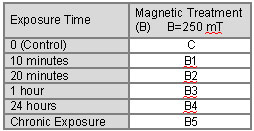
3. RESULTS AND
DISCISSION
Table
2 shows
the germination parameters calculated for tall fescue and alfalfa
seeds, respectively. Germination data corresponding to all the doses
were analyzed and the cumulative curves were plotted, but in this paper
only the curves of the doses which provided the greatest differences
versus control are presented. Results show that the mean germination
time (MGT) of tall fescue seeds was significantly reduced when seeds
were exposed to magnetic field. The greatest differences between
treated seeds and control were obtained when seeds were treated for 24
h and chronically exposed (53.28 h for B4, 53.52 h for B5 vs. 57.84 for
control). In addition, most of parameters were also reduced, i.e. T25
of seeds not exposed to magnetic field was 50.16 h while this value was
significantly reduced for B4 (48.00 h) and B5 (47.28 h); similar
reductions were obtained for the other parameters, in consequence the
germination rate of seeds chronically exposed was increased.
Data obtained for alfalfa seeds (Medicago sativa, L) shows that MGT was
significantly reduced compared to control when seeds were exposed to
magnetic field (20.40 h for B5, 20.88 h for B4, 21.36 h for B2 vs.
25.68 h for control). The time taken for 75% of the control seeds to
germinate (T75) was 30.24 h while the T75 of treated seeds were
significantly reduced, i.e. 22.32 h for B5, 23.76 h for B4, 24.48 for
B3, 24.72 h for B2 and 24.96 h for B1. It is remarkable that parameters
T1 and T10 were reduced when seeds were exposed for 10 minutes (B1);
these values are 29.04 h vs. 37.92 h and 40.56 vs. 45.12 h, therefore,
the onset of germination of alfalfa treated seeds started earlier than
the control.
Cumulative germination curves of tall fescue seeds subjected to 250 mT
stationary magnetic field for 24 hour (B4), chronically exposure (B5)
and control curve are presented in Figure 1a and 1b.

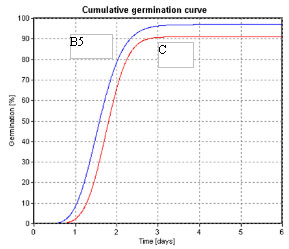
Cumulative
germination curves of Medicago sativa seeds subjected to 250 mT
stationary magnetic field for 24 hour (B4), chronically exposure (B5)
and control curve are plotted in figure 2a and 2b.
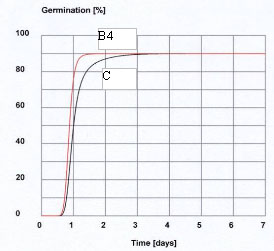
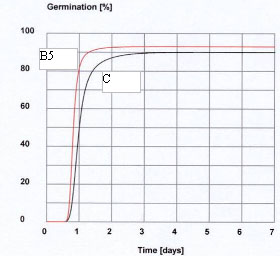
Figure 2.
Germination curves of alfalfa seeds.
In all
cases,
the germination curve of control is underneath the curves of treated
seeds, then, control germination rate is lower than the corresponding
to magnetic doses.
Results obtained for grass seeds are according with other studies about
the influence of a stationary magnetic field on several seed
germination and plant growth which reveal that magnetic treatment
produces: an improvement of percentage and rate of germination of
exposed seeds (Carbonell et al.). A biostimulation on the initial
growth stages of barley and wheat have been found by Martínez et
al. (2000, 2002). An early sprouting and first stages of growth of
treated rice plants have been publish by Flórez et al. (2004);
results obtained showed increases in germination rate and plant weight
and length greater when seeds were subjected to magnetic treatment than
their controls. Podlesni et al. (2004) confirmed the positive effect of
the magnetic treatment on the germination and emergence of bean
cultivars; plant emergence from magnetized seeds was 2-3 days earlier
compared to the control, the yield was increased due to the higher
number of pods per plant. Racuciu et al. (2006) reported that the
length of young plants of maize exposed to a magnetic field varying
from 50 to 250 mT, were higher than control for all exposed samples.
Legend of table 2: C (Control), B1 (10 min.), B2 (20 min), B3 (1hour),
B4 (24 hour), B5 (chronic exposure), Gmax: number of germinated seeds
(%); T1, T10, T25, T50 and T75: time needed to obtain 1, 10, 25, 50 and
75 % of germination; MGT: mean germination time. Asterisks indicate
significant differences vs. control: **** (p<0.001) very strongly
significant; strongly significant ***(0.001<p<0.01); significant
**(p<0.05).
Table 2.
Germination parameters for grass seeds exposed to a stationary magnetic
field, expressed as mean and standard error.
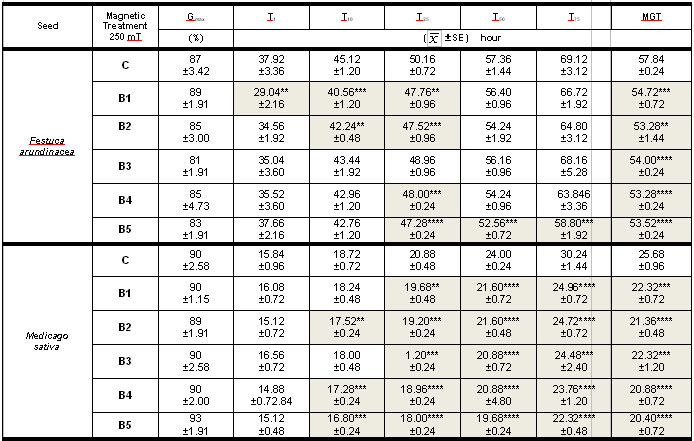
4. CONCLUSION
For both studied seeds (Festuca arundinacea and Medicago sativa, L) the
mean germination time (TMG) and parameters T1-T75 were reduced for all
magnetic doses applied, then, rate of treated seeds is higher than the
control. In summary, stationary magnetic field could be used as a
physical technique to improve the germination of grass seeds.
5. REFERENCES
Aladjadjiyan, A., Study of the influence of magnetic field on some
biological characteristics of Zea mais.( 2002). Journal Central
European Agriculture, 3 (2), pp. 89-94.
Carbonell, M.V., Martínez, E. & Amaya, J.M.,(2000).
Stimulation of germination in rice (Oryza sativa, L.) by a static
magnetic field. Electro-and Magnetobiology, 19 (1), pp. 121-128.
Flórez, M., Carbonell, M.V. & Martínez, E. (
2004). Early sprouting and first stages of growth of rice seeds
exposed to a magnetic field. Electro-and Magnetobiology, 23 (2), pp.
167-176.
Flórez, M, Carbonell, M.V.; Martínez, E.,( 2007).
Exposure of maize seeds to stationary magnetic field: .effects on
germination and early growth. Environmental and Experimental Botany 59,
68-75.
ISTA. International Rules for Seed Testing.( 2004). International Seed
Testing Assoc. Zurich. (Switzerland).
Martínez, E., Carbonell, M.V.& Amaya, J.M. (2000). A Static
magnetic field of 125 mT stimulates de initial growth stages of barley
(Hordeum vulgare, L.). Electro-and Magnetobiology, 19(3), pp. 271-277.
Martínez, E., Carbonell, M.V. & Flórez, M., (2002).
Magnetic biostimulation of initial growth stages of wheat (Triticum
aestivum, L.). Electromagneto-biology and Medicine, 21 (1), pp. 43-53.
Pietruszweski, S., (1996).Effects of magnetic biostimulation of wheat
seeds on germination, yield and proteins. Int Agrophysics, 10 (1), pp.
51-55.
Podlesni, J., Pietruszewski, S.,(2004).Podlesna, A. Efficiency of the
magnetic treatment of broad bean seeds cultivated under experimental
plot conditions. International Agrophysics, 18 (1), 65-71.
Racuciu, M., Calugaru, G.H., Creangia, D.E. Static magnetic field
influence on some plant growth. Rom. Journal Physics, 1 (2), 241-251.
Yano, A., Hidaka, E., Fujiwara, K. & Iimoto, M.,(2001). Induction
of primary root curvature in radish seedlings in a static magnetic
field. Biolelectromagnetics, 22, pp. 194-199.
Yinan, L., Yuan, L., Yongquing, Y. & Chunyang, L., (2005). Effect
of seed pre-treatment by magnetic field on the sensitivity of cucumber
(Cucumis sativus) seedlings to ultraviolet-B radiation. Environmental
and Experimental Botany, 54, pp. 286-294.
 |
Mayor
información |
Facultad
de
Ingeniería - Escuela de Ingeniería de los Recursos
Naturales y del Ambiente EIDENAR
c.e.: eidenar@univalle.edu.co
Telefax: +57 2 3212153 - +57 2 3212159
Edificio 344 - Ciudadela Universitaria Meléndez
Universidad del Valle
Cali, Colombia
©2009 - Universidad del Valle -Luis Eduardo González
Muñeton
|
|
|
|
|
|
|
|